Identifying Effect of Car Fire Blankets on Chosen Fire Parameter Using Large-Scale Fire Tests of Internal Combustion Engine Vehicle and High-Voltage Traction Battery—Comparative Slovak Case Study
Abstract
:1. Introduction
2. Materials and Methods
2.1. Description of Samples—Car Fire Blanket


2.2. The Preparation of the Experiment

- T0 on the driver’s side at a distance of 0.7 m and a height of 1 m;
- T1 inside the vehicle approximately in the middle at headrest height;
- T2 on the roof of the vehicle approximately in the middle (contact point of the car fire blanket and vehicle);
- T3 on the passenger side at a distance of 0.7 m and a height of 1 m.
- T0 on the left side at a distance of 0.7 m and a height of 0.5 m;
- T1 at the point of connection of the battery to the vehicle (top side);
- T2 inside on the opposite side of initiation;
- T3 on the right side (initiation side) at a distance of 0.7 m and a height of 0.5 m.
2.3. The Course of the Experiment
- The placement of the ICEV/HTB on a concrete base.
- The preparation of the accelerator and subsequent initiation of the fire.
- For a large-scale ICEV fire test, apply the car fire blanket at an interval of 10 min when the temperature reaches 700 °C in the interior of the ICEV (T1).For a large-scale HTB fire test—apply the car fire blanket at an interval of 10 min when the temperature reaches 700 °C inside the HTB (T2). In case of any changes, apply a car fire blanket at different temperatures.
- Remove the fire blanket from the vehicle, and, if necessary, extinguish the fire.
- Reduced visibility, especially in enclosed spaces (garages, parking buildings).
- The necessity of using personal protective equipment (limitation and slowing down of movement).
- Narrow space for maneuvering the vehicle.
- The potential slope of the surface where the vehicles are positioned.
3. Results
3.1. Results of Large-Scale ICEV Fire Test
3.2. Results of Large-Scale HTV Fire Test
4. Discussion
- T0 Driver (ICEV) and T0 Left Side (HTB)—red color;
- T1 Interior (ICEV) and T2 Interior (HTB)—orange color;
- T2 Roof (ICEV) and T1 Surface (HTB)—green color;
- T3 Passenger (ICEV) and T0 Right Side (HTB)—blue color.
5. Conclusions
- The application of the car fire blanket has a significant impact on the temperature decrease in the interior (temperature dropped by 584 °C) but also on the body (temperature dopped by 97 °C) of the ICEV. Thermocouples T0 and T3 at a lateral distance of 0.7 m did not measure significant temperatures during the whole experiment.
- In the large-scale ICEV fire test, the maximum temperature reached was 724 °C in thermocouple T1 located in the interior.
- There was no significant impact on temperature decrease after the car fire blanket application in the large-scale HTB fire test.
- The large-scale HTB fire test results show that after car fire blanket application, the temperature inside the HTB increased (temperature rose by 39 °C).
- Mechanical damage to the integrity of the HTB enclosure did not initiate a long-term lithium fire in the HTB fire test.
- In the large-scale HTB fire test, the maximum temperature reached was 335 °C in thermocouple T0 located on the left side at a lateral distance of 0.7 m.
Author Contributions
Funding
Institutional Review Board Statement
Informed Consent Statement
Data Availability Statement
Acknowledgments
Conflicts of Interest
References
- Ministry of Interior—Total Number of Registered Vehicles in Slovak Republic. Available online: https://www.minv.sk/?celkovy-pocet-evidovanych-vozidiel-v-sr (accessed on 2 March 2024). (In Slovak).
- Ministry of Interior—Number of Registered Electric and Hybrids Vehicles. Available online: https://www.minv.sk/?pocet-evidovanych-elektromobilov-a-hybridov (accessed on 2 March 2024). (In Slovak).
- Ministry of Interior—Fire Statistics in Slovakia. Available online: https://www.minv.sk/?statistika-poziarovosti-na-slovensku-2 (accessed on 5 March 2024). (In Slovak).
- Arvidson, M.; Gehandler, J.; Bleye, J. Fire suppression and manual firefighting of battery electric vehicle fires on ro-ro ships. In Proceedings of the Seventh International Conference on Fires in Vehicles, Stavanger, Norway, 24–25 April 2023. [Google Scholar]
- Sturm, P.; Fößleitner, P.; Fruhwirt, D.; Galler, R.; Wenighofer, R.; Heindl, S.F.; Krausbar, S.; Hegerf, O. Fire tests with lithium-ion battery electric vehicles in road tunnels. Fire Saf. J. 2022, 134, 103695. [Google Scholar] [CrossRef]
- Wijesekere, T.; Funk, E.; Wilkens, K.; Husted, B. Long-scale tests of firefighting technologies for electric vehicle fires on board ro-ro ferries. In Proceedings of the Seventh International Conference on Fires in Vehicles, Stavanger, Norway, 24–25 April 2023. [Google Scholar]
- Kwon, J.; Kim, H.; Lee, S.; Kim, S.; Park, T.; Kim, T.; Kim, S. Application of Car Fire Blankets to Car Fires. Fire Sci. Eng. 2021, 35, 143–149. [Google Scholar] [CrossRef]
- Chen, X.; Shen, W.; Vo, T.T.; Cao, Z.; Kapoor, A. An overview of lithium-ion batteries for electric vehicles. In Proceedings of the 10th International Power & Energy Conference, Ho Chi Minh, Vietnam, 12–14 December 2012. [Google Scholar]
- Zhao, C.; Wang, T.; Huang, Z.; Wu, J.; Zhou, H.; Ma, M.; Xu, J.; Wang, Z.; Li, H.; Sun, J.; et al. Experimental study on thermal runaway of fully charged and overcharged lithium-ion batteries under adiabatic and side-heating test. J. Energy Storage 2021, 38, 102519. [Google Scholar] [CrossRef]
- Mallick, S.; Gayen, D. Thermal behavior and thermal runaway propagation in lithium-ion battery systems—A critical review. J. Energy Storage 2023, 62, 106894. [Google Scholar] [CrossRef]
- Sun, P.; Willstrand, O.; Rosengren, M. A review of Battery Fires in Electric Vehicles. Fire Technol. 2020, 56, 1361–1410. [Google Scholar] [CrossRef]
- Bisschop, R.; Willstrand, O.; Rosengren, M. Handling Lithium-Ion Batteries in Electric Vehicles: Preventing and Recovering from Hazardous Events. Fire Technol. 2020, 56, 2671–2694. [Google Scholar] [CrossRef]
- Ghiji, M.; Novozhilov, V.; Moinuddin, K.; Joseph, P.; Burch, I.; Suendermann, B.; Gamble, G. A Review of Lithium-Ion Battery Fire Suppression. Energies 2020, 13, 5117. [Google Scholar] [CrossRef]
- Hynynem, J.; Quant, M.; Pramanik, R.; Olofsson, A.; Li, Y.Z.; Arvidson, M.; Andersson, P. Electric Vehicle Fite Safety in Enclosed Spaces; RISE Research Institutes of Sweden: Gothenburg, Sweden, 2023; pp. 8–28. [Google Scholar]
- Lecocq, A.; Bertana, M.; Truchot, B.; Marlair, G. Comparison of the fire consequences of an electric vehicle and an internal combustion engine vehicle. In Proceedings of the International Conference on Fires in Vehicles FIVE, Chicago, IL, USA, 27–28 September 2012. [Google Scholar]
- Lecocq, A.; Bertana, M.; Truchot, B.; Marlair, G. Comparison of fire behaviours of an electric-battery-powered behicle and gasoline-powered vehicle in a real-scale fire test. In Proceedings of the International Conference on Fires in Vehicles FIVE, Chicago, Il, USA, 27–28 September 2012. [Google Scholar]
- Willstrand, O.; Bisschop, R.; Blomqvist, P.; Temple, A.; Anderson, J. Toxic Gases from Fire in Electric Vehicles; RISE Research Institutes of Sweden: Gothenburg, Sweden, 2020; pp. 8–51. [Google Scholar]
- Li, D.; Zhu, G.; Zhu, H.; Yu, Z.; Gao, Y.; Jiang, X. Flame spread and smoke temperature of full-scale fire test of car fire. Case Stud. Therm. Eng. 2017, 10, 315–324. [Google Scholar] [CrossRef]
- Jiang, X.; Zhu, G.; Zhu, H.; Li, D. Full-scale Experimental Study of Fire Spread Behavior of Cars. Procedia Eng. 2018, 211, 297–305. [Google Scholar] [CrossRef]
- Okamoto, K.; Watanabe, N.; Hagimoto, Y.; Chigira, T.; Masano, R.; Miura, H.; Ochiai, S.; Satoh, H.; Tamura, Y.; Hayano, K.; et al. Burning behavior of sedan passenger cars. Fire Saf. J. 2009, 44, 301–310. [Google Scholar] [CrossRef]
- Kang, S.; Kwon, M.; Choi, J.Y.; Choi, S. Full-scale fire testing of battery electric vehicles. Appl. Energy 2023, 332, 120497. [Google Scholar] [CrossRef]
- Cui, Y.; Liu, J.; Cong, B.; Han, X.; Yin, S. Characterization and assessment of fire evolution process of electric vehicles placed in parallel. Process Saf. Environ. Prot. 2022, 166, 524–534. [Google Scholar] [CrossRef]
- Cui, Y.; Cong, B.; Liu, J.; Qiu, M.; Han, X. Characteristics and Hazards of Plug-In Hybrid Electric Vehicle Fires Caused by Lithium-Ion Battery Packs with Thermal Runaway. Front. Energy Res. 2022, 10, 878035. [Google Scholar] [CrossRef]
- STN 73 6058:1987; Multi-Story and Underground Garages. Basic Principles. Slovak Technical Standard: Bratislava, Slovakia, 1987.
- Niroomand, N.; Bach, C.; Elser, M. Vehicle Dimensions Based Passenger Car Classification using Fuzzy and Non-Fuzzy Clustering Methods. Transp. Res. Rec. 2021, 10, 184–194. [Google Scholar] [CrossRef]
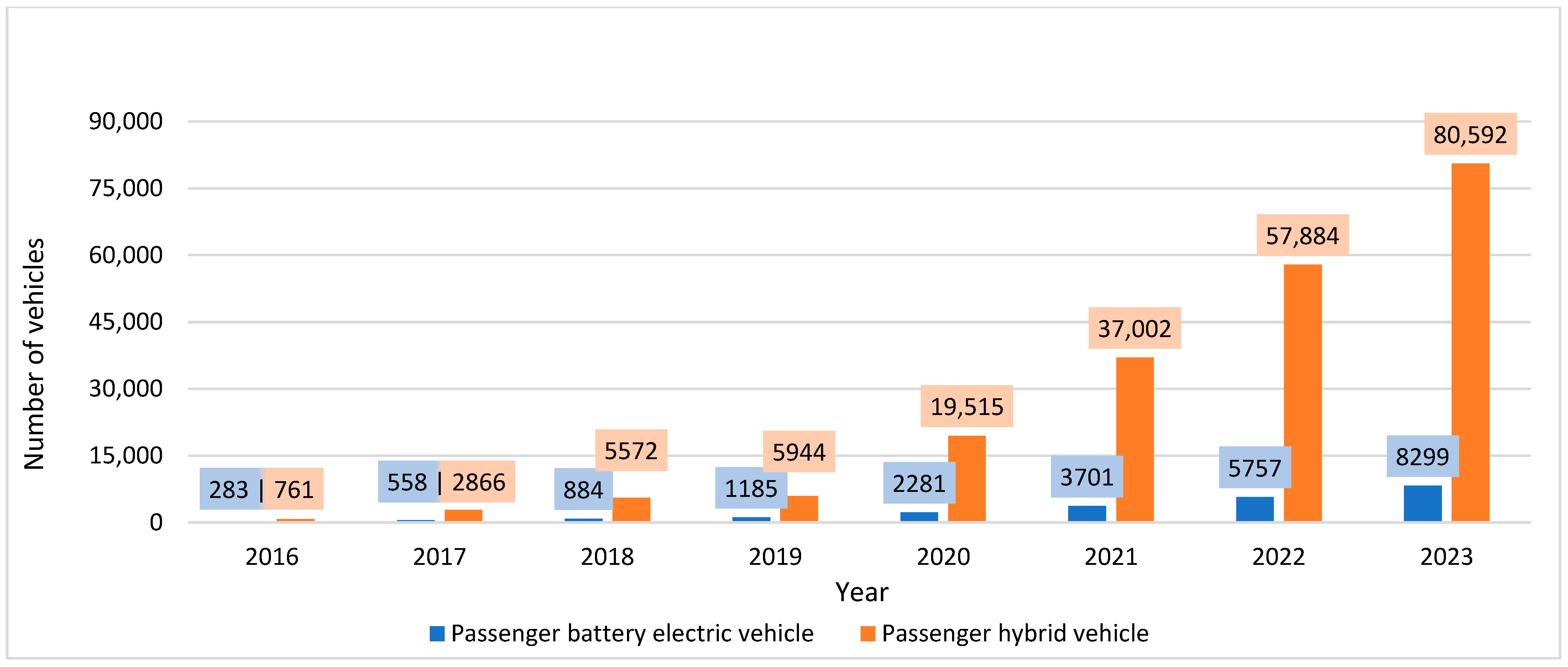
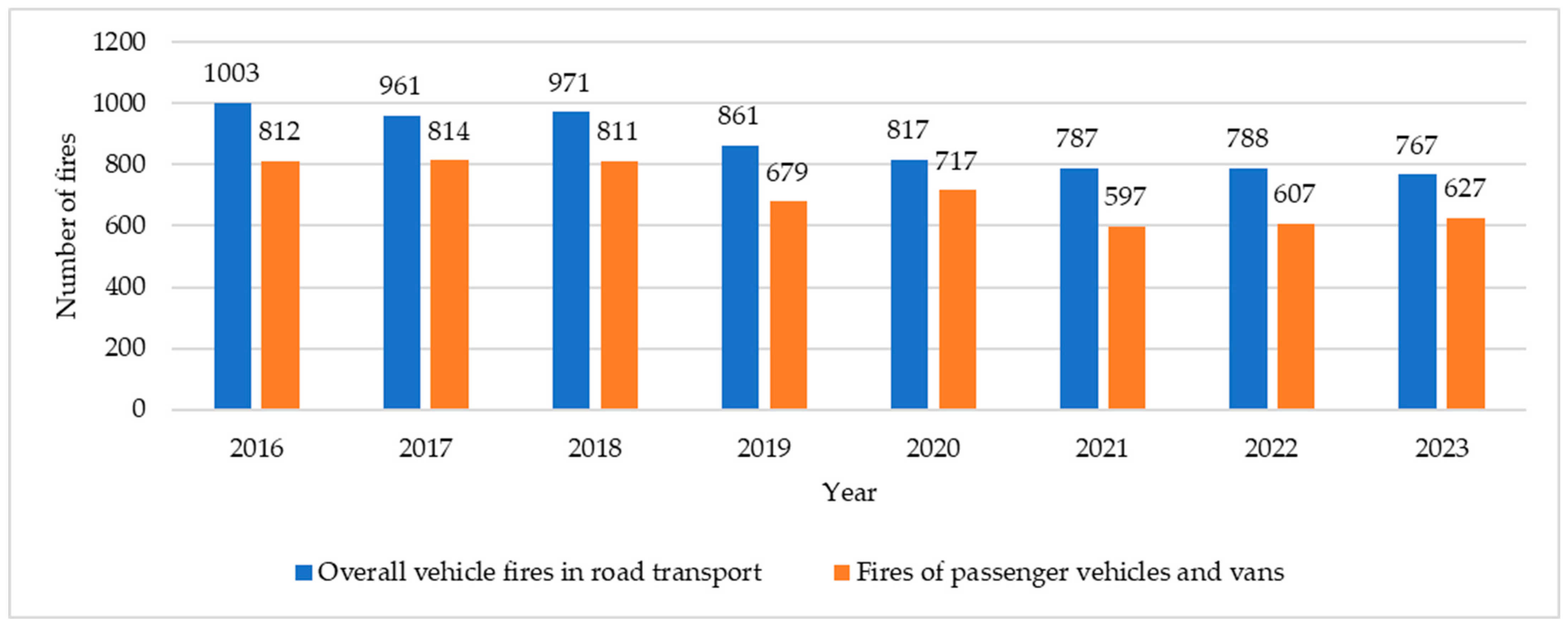
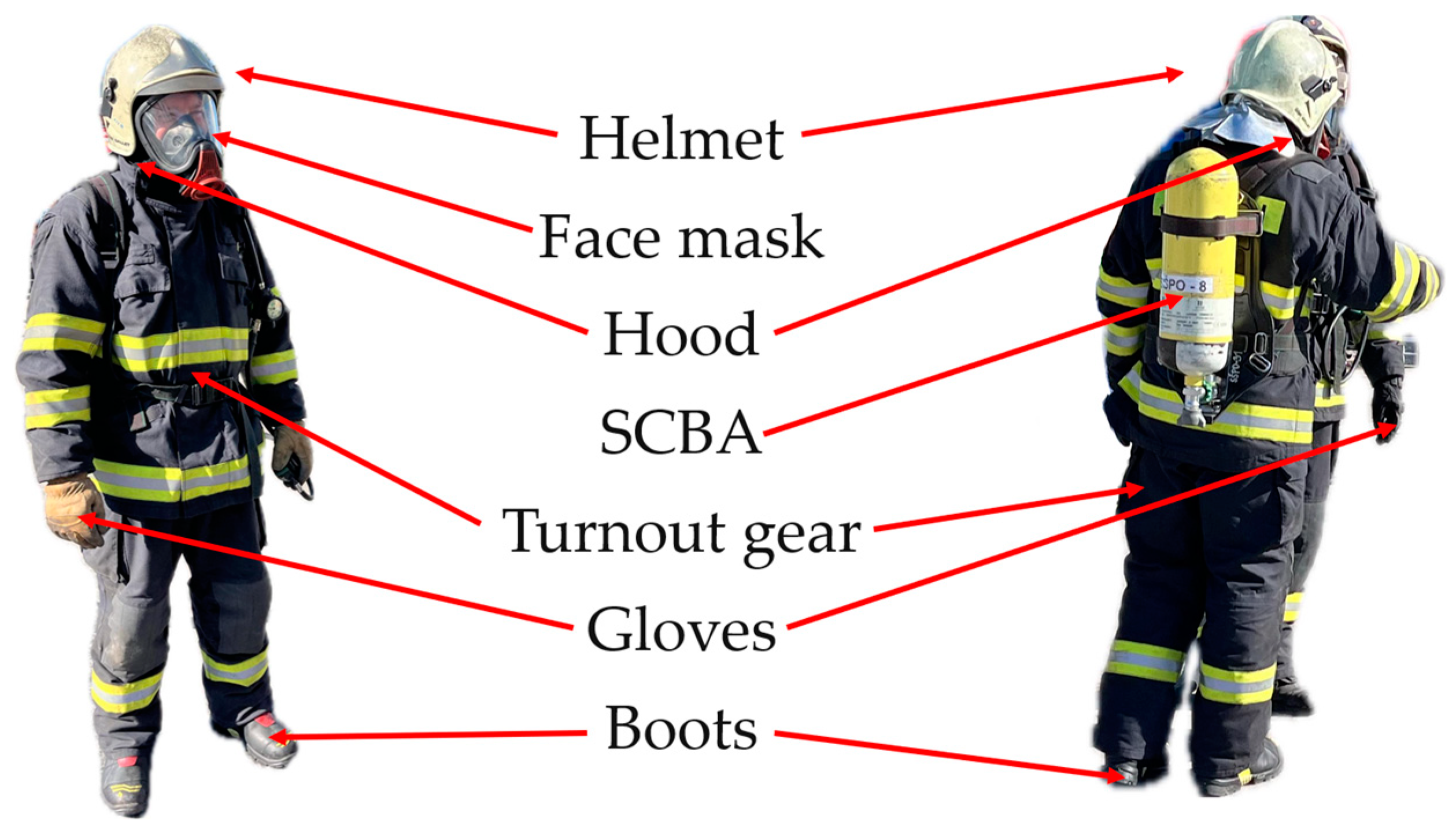

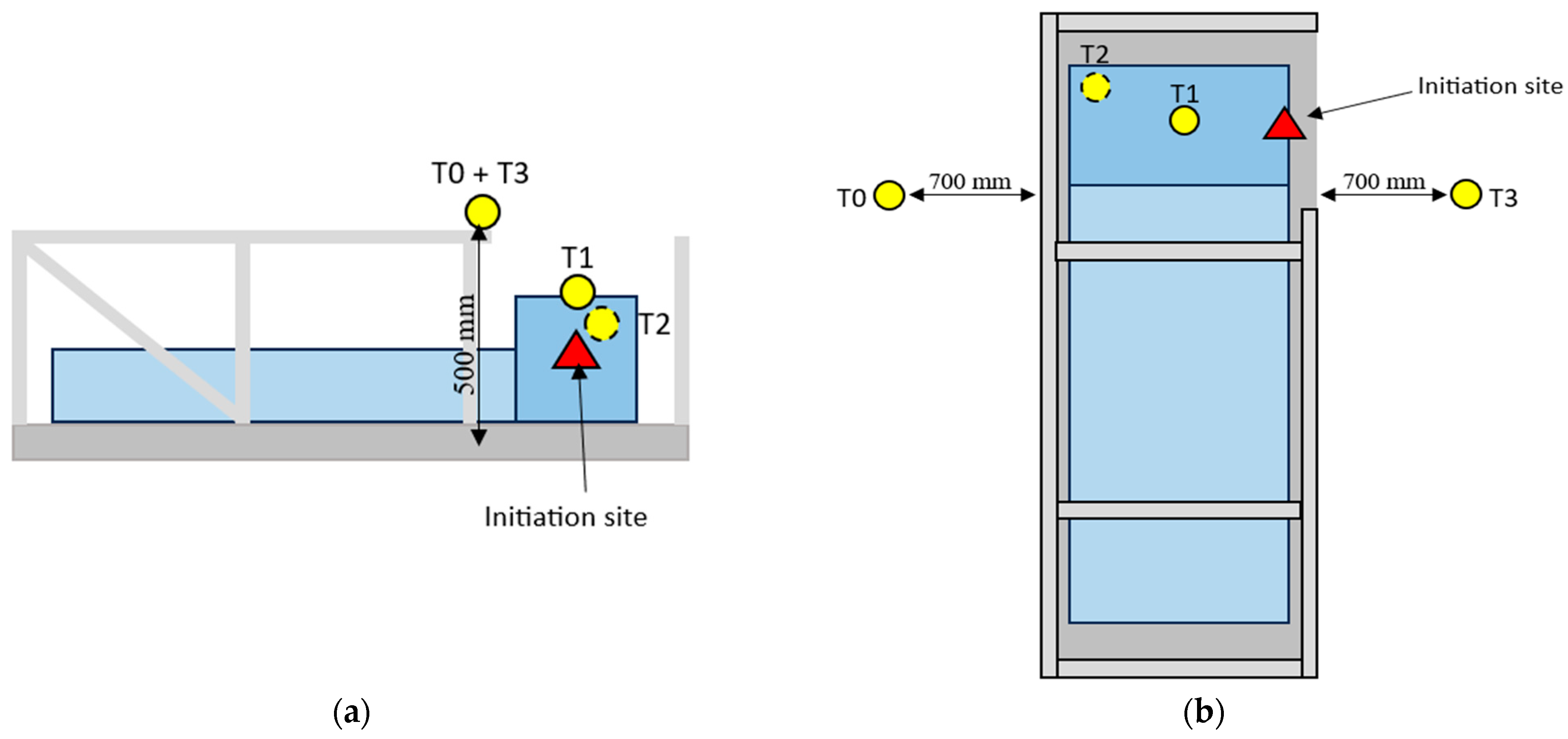

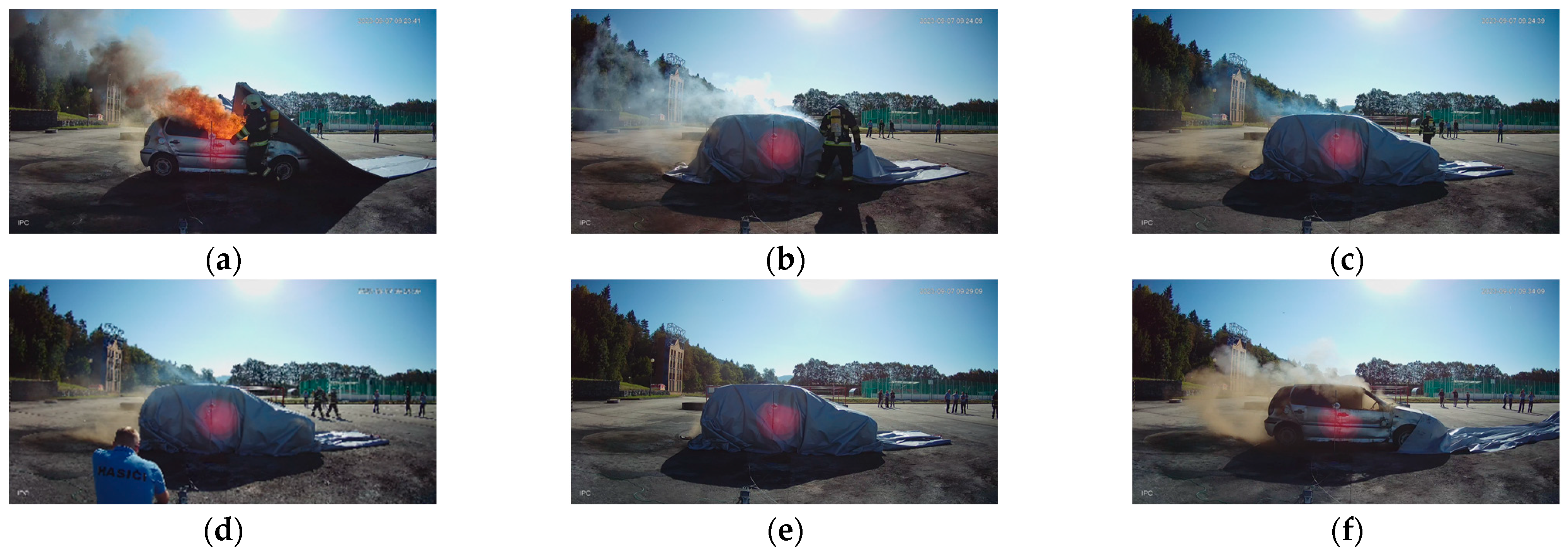
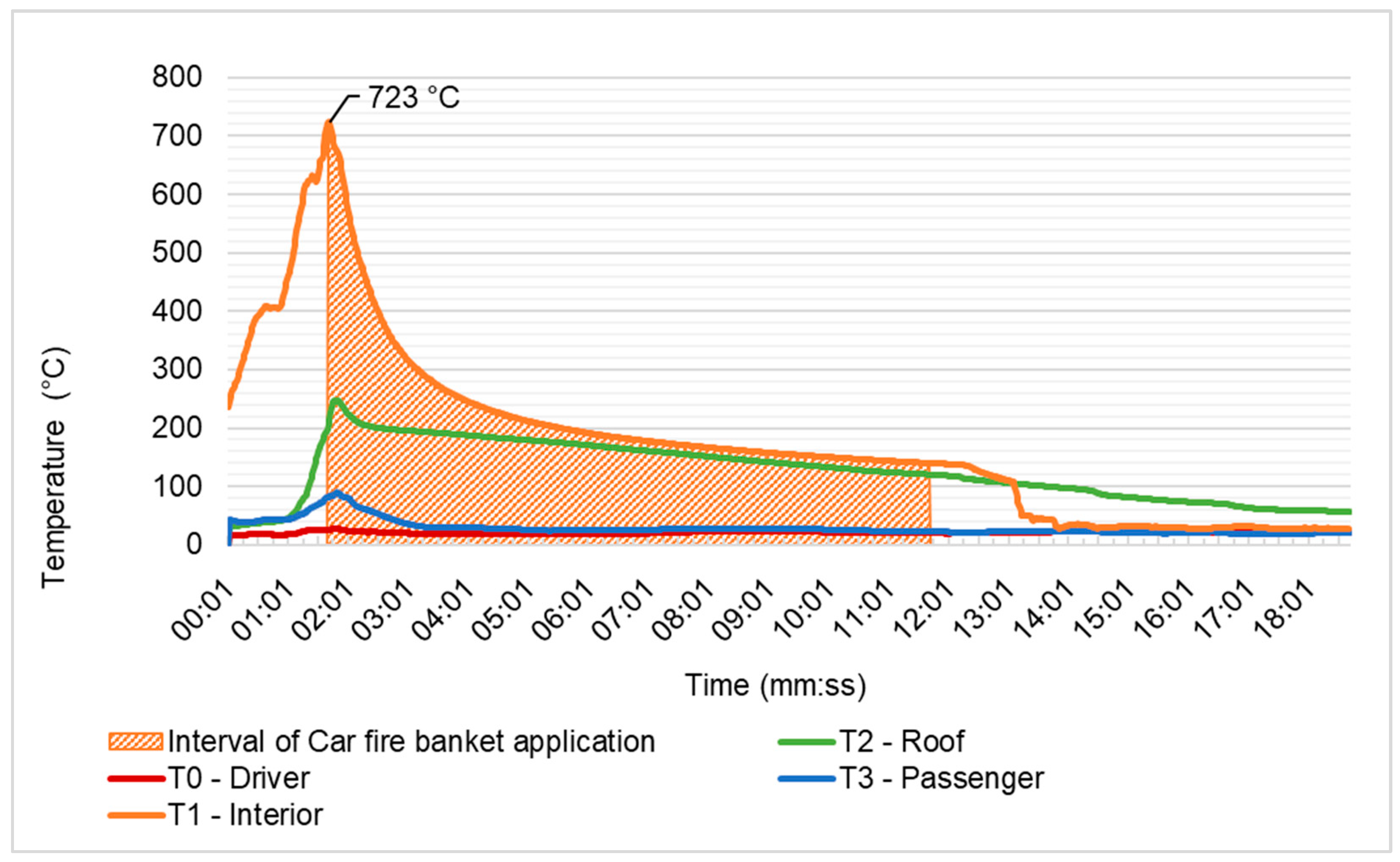


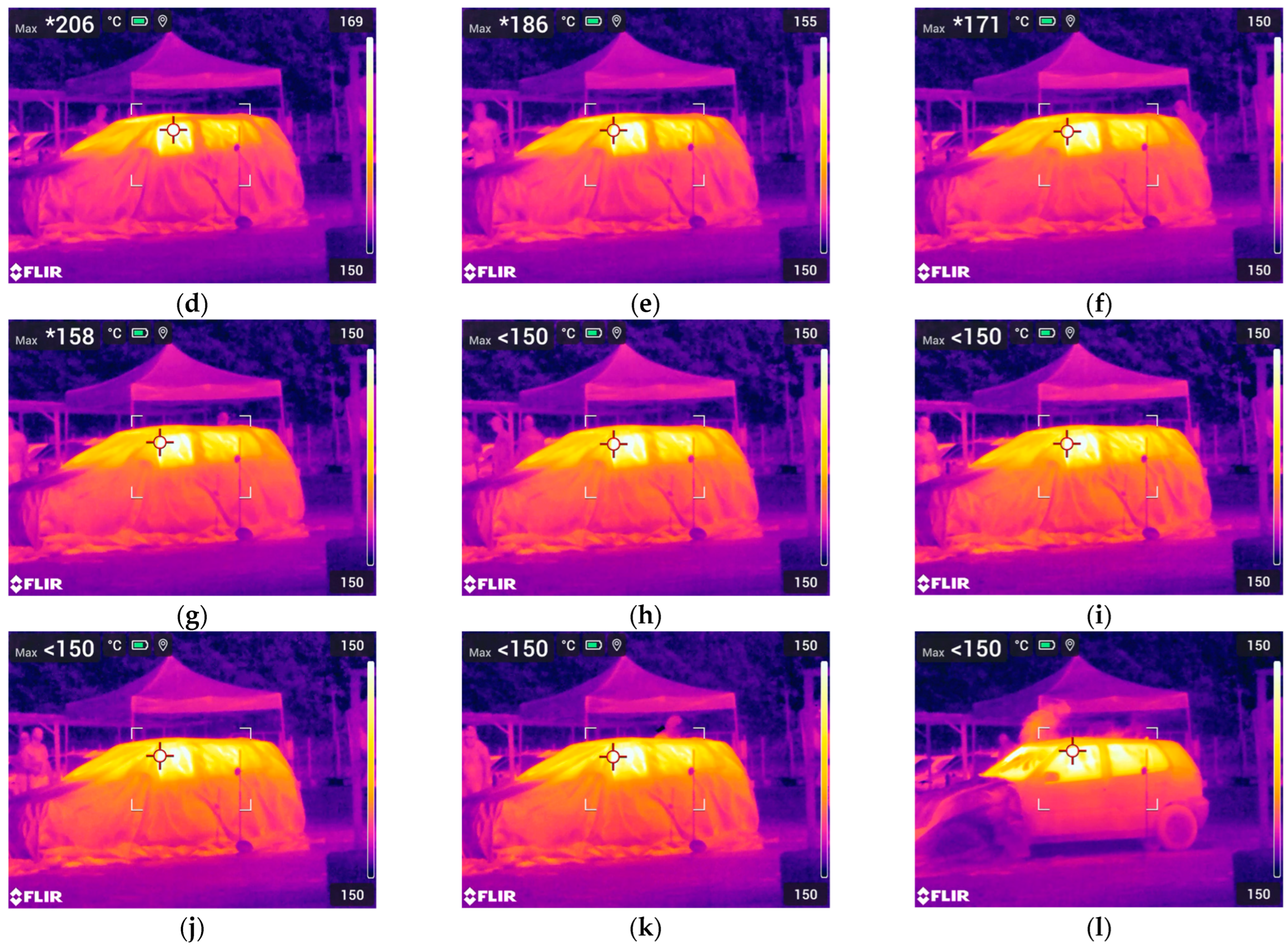
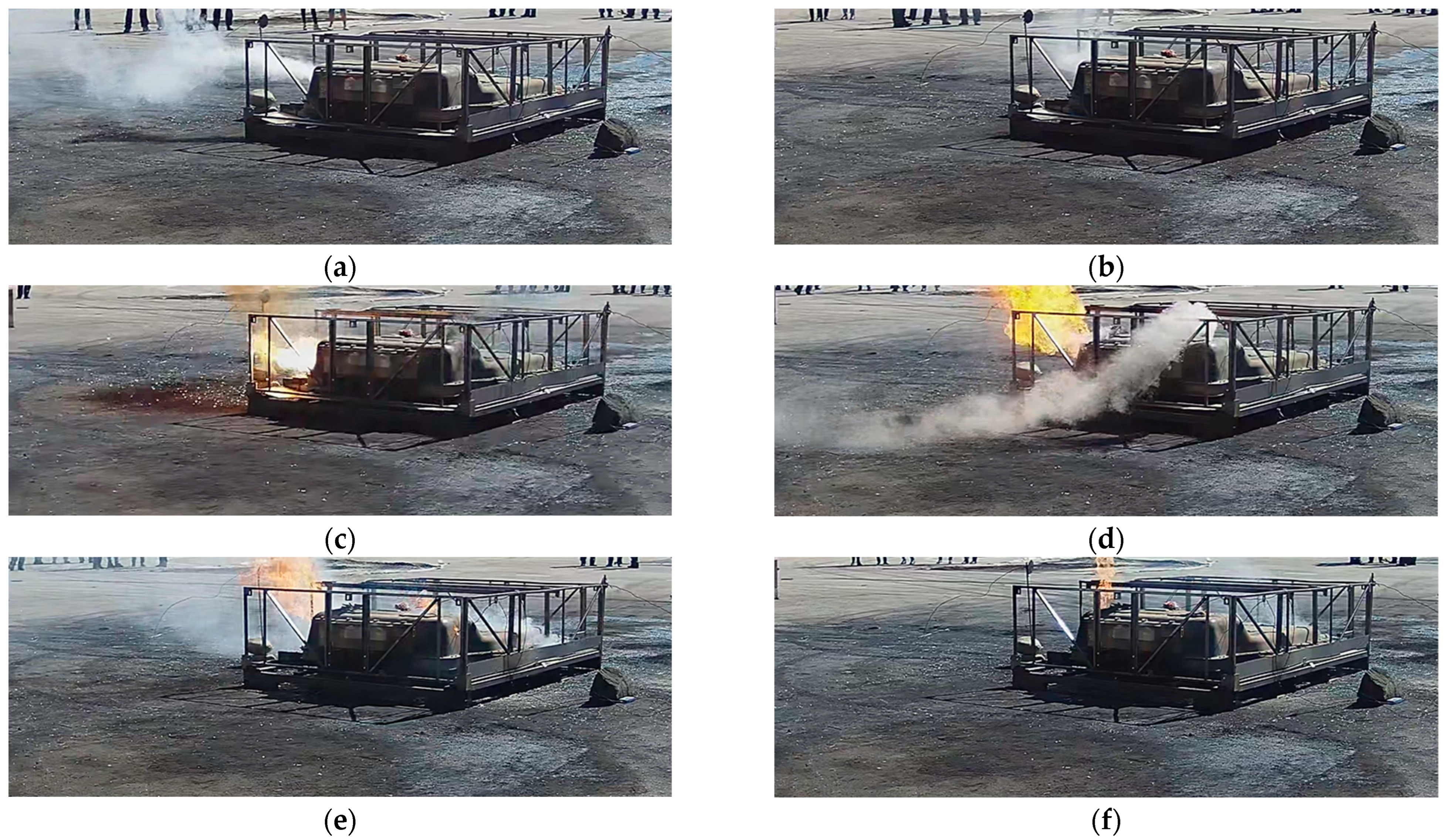

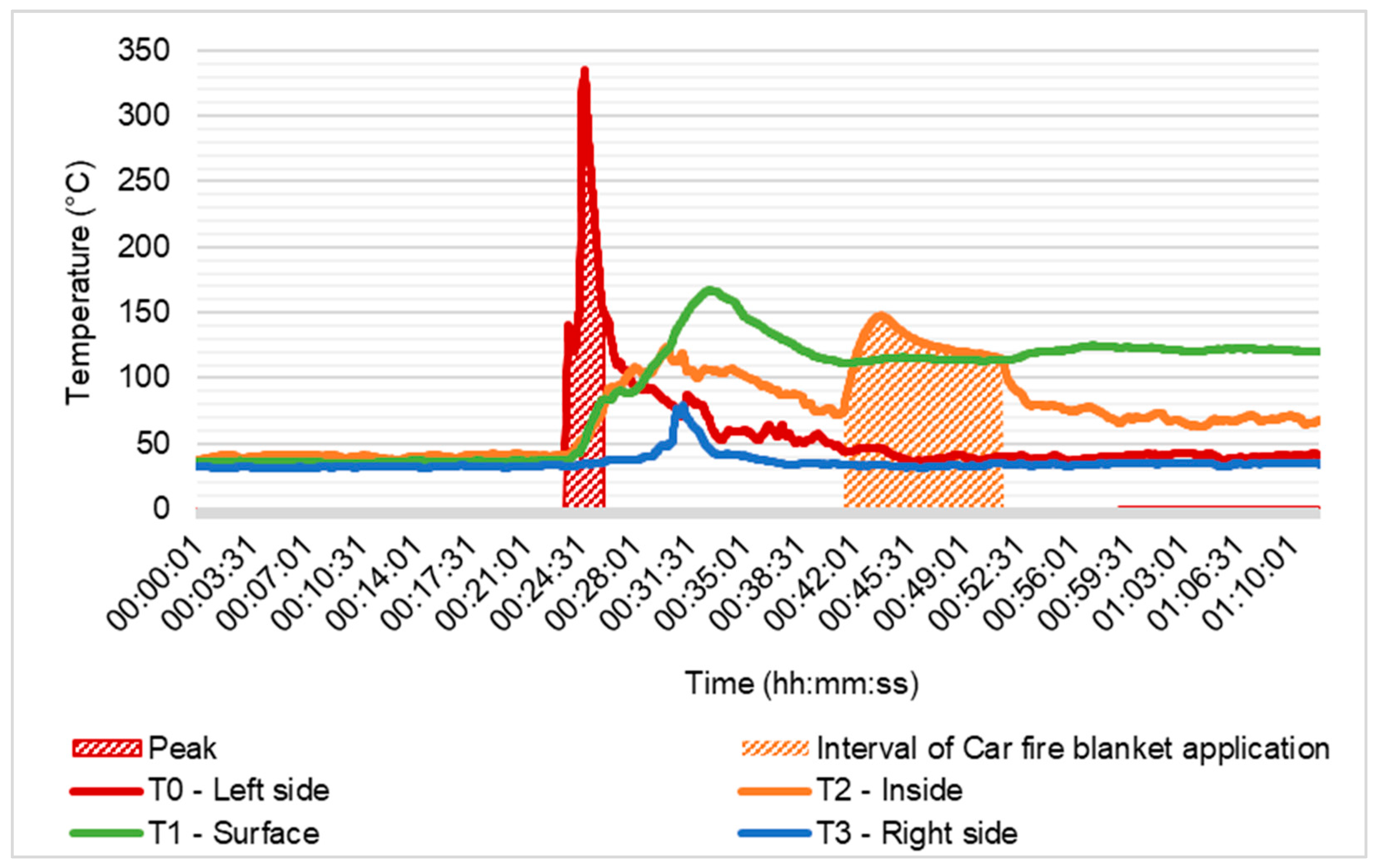

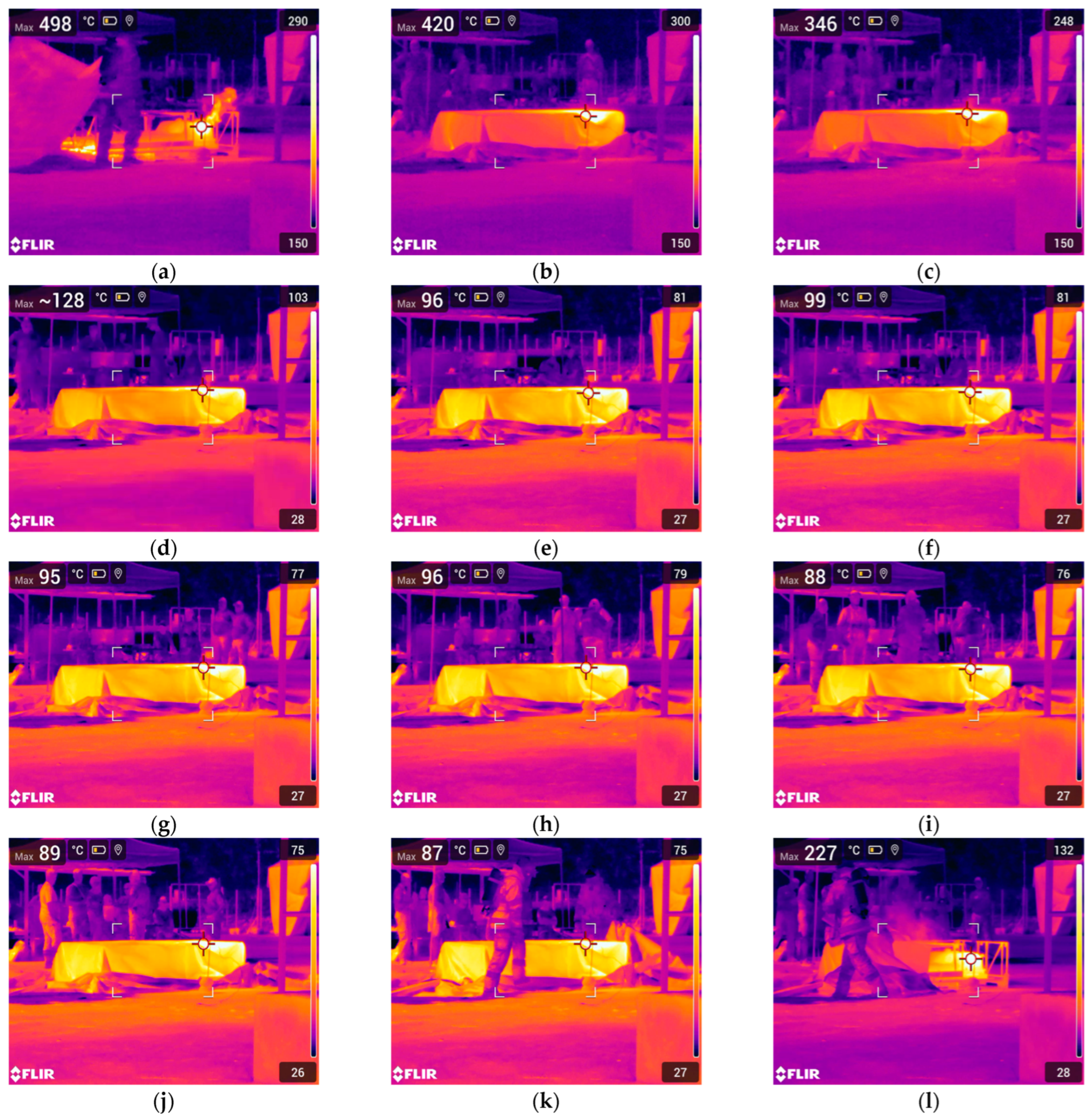
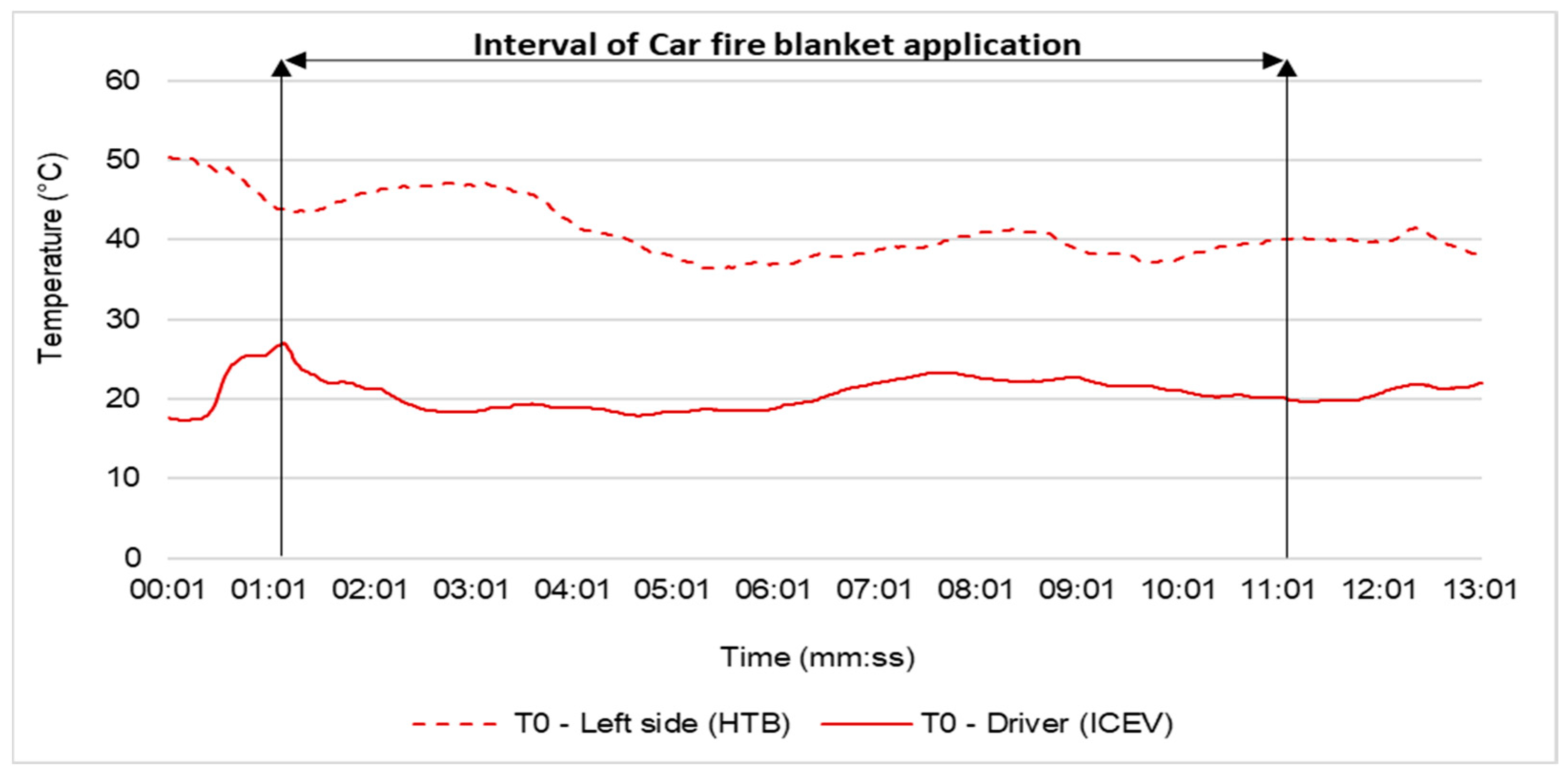
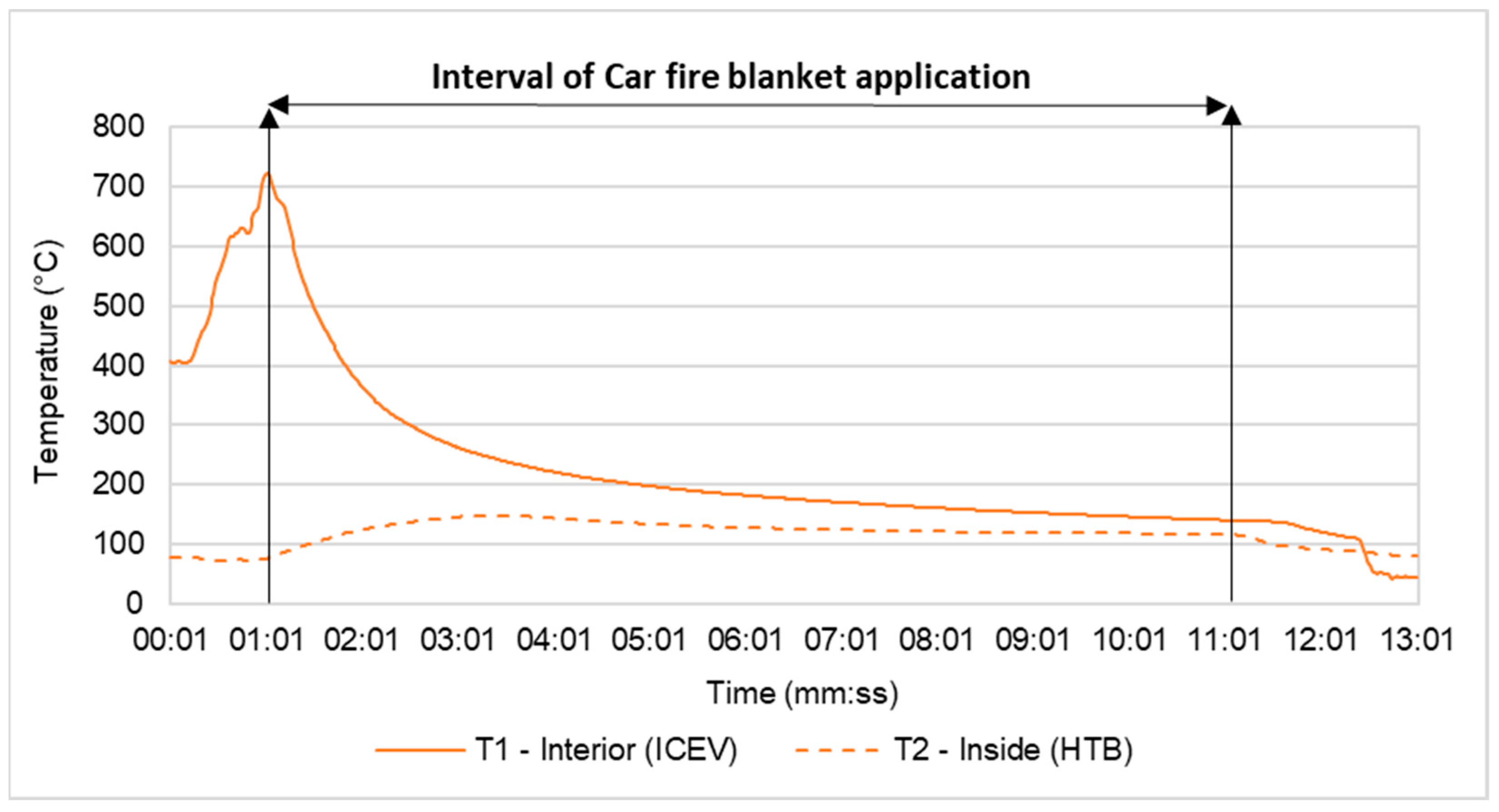
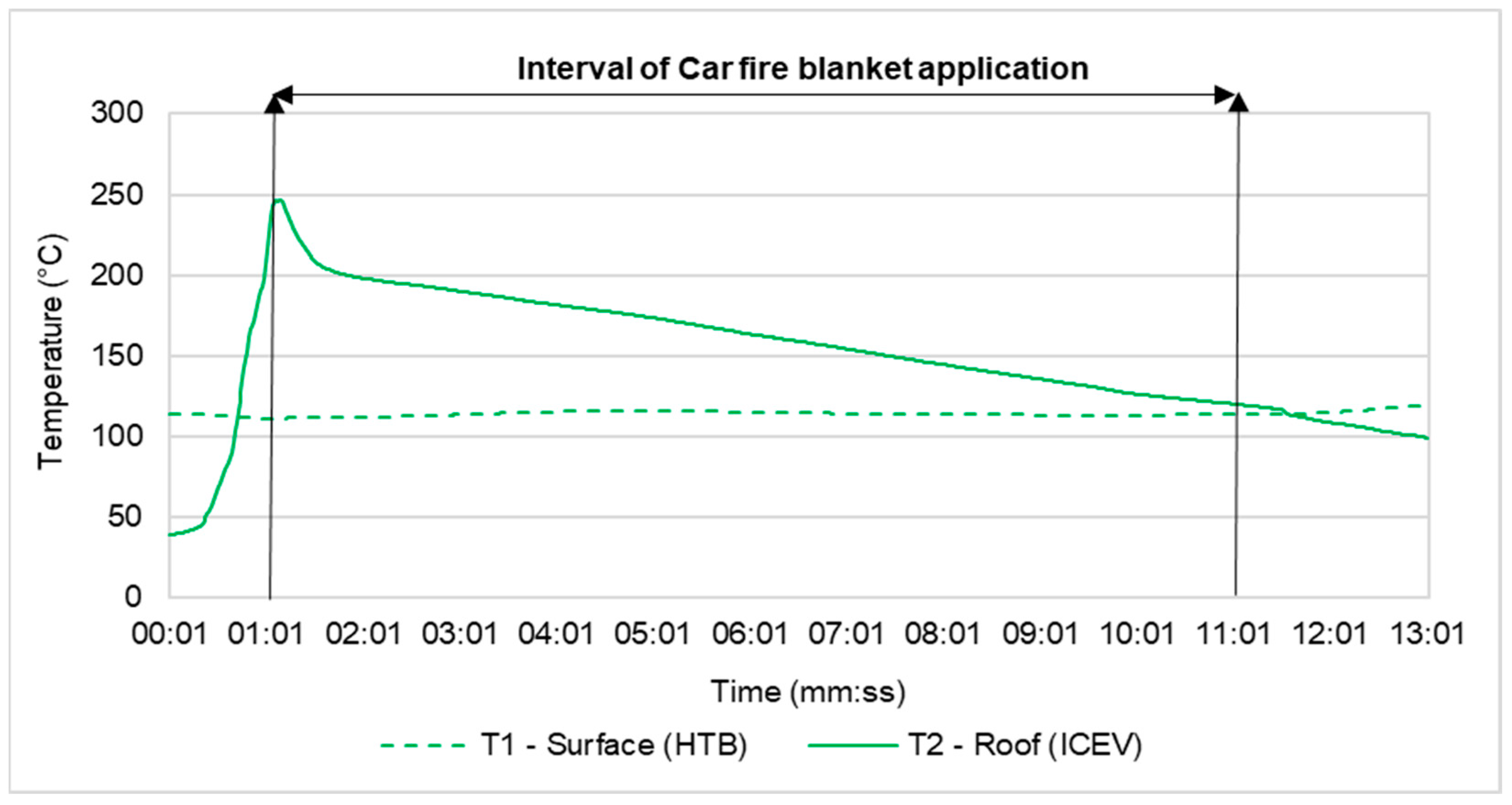
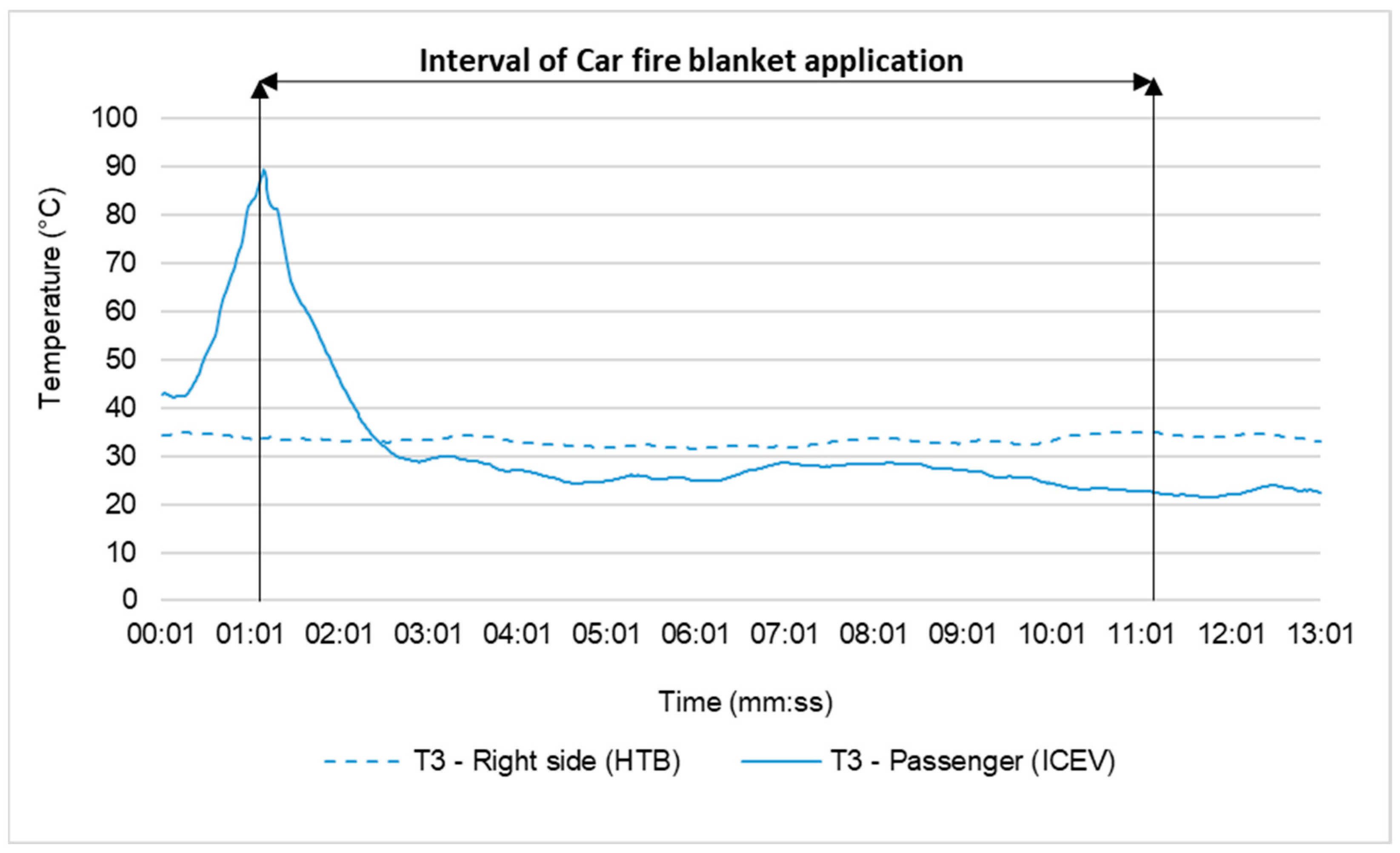
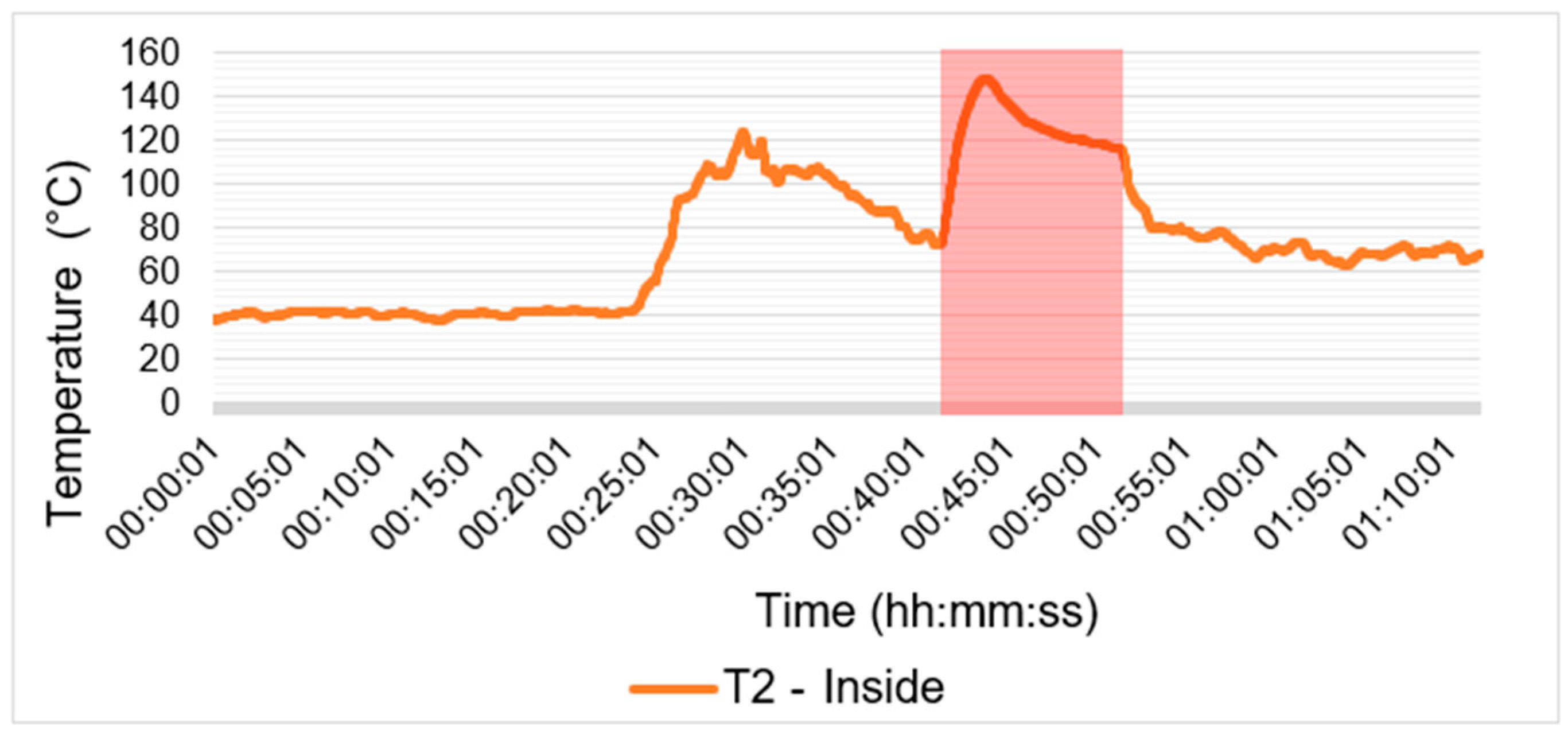

| Tool | Dimension (m) | Weight (kg) | Long-Term TR 1 (°C) | Short-Term TR 1 (°C) | Repeated Use | Price (EUR) |
|---|---|---|---|---|---|---|
| Car Fire Blanket | 6 × 9 | 27 | 1000 | 1300 | 30 times | 1140 |
| Experiment | Large-Scale ICEV Fire Test | Large-Scale HTB Fire Test | ||||
|---|---|---|---|---|---|---|
| Parameter | Initiation | Application of FB | Removing of FB | Initiation | Application of FB | Removing of FB |
| Air temperature (°C) | 28.7 | 35 | 36.5 | 37.6 | 38 | 38.4 |
| Wind speed (m/s) | 1 | 1 | 1 | 1.5 | 1.5 | 1.5 |
| Wind direction | NNE | NNE | NNE | NNE | NNE | NNE |
| Humidity (%) | 28 | 22 | 19 | 10 | 10 | 7 |
| Precipitation (mm) | 0 | 0 | 0 | 0 | 0 | 0 |
| Pressure (hPa) | 992 | 992 | 992 | 991 | 991 | 991 |
| Initiation of experiments | Accelerator—gasoline (2 dcL) Initiator—flame (torch) | Mechanical integrity damage—iron spike and hammer | ||||
| Samples of the experiment | Internal combustion engine vehicle (ICEV) (Figure 4) | High-voltage traction battery (HTB) (Figure 5) | ||||
| Car fire blanket | ||||||
| Monitored parameters | Temperature (°C) throughout the course of the experiments | |||||
| Temperature (°C) during the application of the car fire blanket to the ICEV and HTB fire | ||||||
| Time (hh:mm:ss)/(mm:ss) | ||||||
| Monitoring equipment and tools | Thermocouples NiCr-Ni 4 pcs | |||||
| Datalogger ALMEMO 2690-8 (Figure 6a) | ||||||
| Video camera 2 pcs | ||||||
| Thermal imaging camera of an unknown brand 1 pcs | ||||||
| Thermal imaging camera FLIR E96 14° 1 pcs | ||||||
| Parameter | Battery Pack |
|---|---|
| Number of modules in pack | 7 |
| Cell type | Pouch cells 3.6 V; 63 Ah; weight 0.882 kg |
| Cells per Module | 42 |
| Number of cells | 294 |
| Configuration | 98s 3p |
| Anode material | Carbon Graphite |
| Cathode material | NMC 622 |
| Separator | Ceramic coated |
| Electrolyte | Organic carbonates |
| Usable energy | 64 kWh (Total = 67.5 kWh) |
| Nominal voltage | 356 V (3.6 V per cell) |
| Nominal Capacity | 189.6 Ah |
| SOC | Usable 94.8% |
| Pack Mass | 425 kg |
| Cell Mass | 259 kg |
| Pack Cells | 193 kg |
| Experiment Progress | ICEV | HTB |
|---|---|---|
| Time (mm:ss) | Time (hh:mm:ss) | |
| Beginning | 00:00 | 00:00 |
| Initiation | 00:01 | 00:23:32 |
| FB Applied | 01:41 | 00:41:20 |
| FB Removed | 11:54 | 00:51:31 |
| Extinguishing | 13:03 | - |
| Termination | 18:41 | 01:11:44 |
| Name | ICEV | HTB |
|---|---|---|
| T0—Driver (ICEV) T0—Left side (HTB) | 21 °C | 41 °C |
| T1—Interior (ICEV) T2—Inside (HTB) | 225 °C | 114 °C |
| T2—Roof (ICEV) T1—Surface (HTB) | 164 °C | 125 °C |
| T3—Passenger (ICEV) T3—Right side (HTB) | 31 °C | 33 °C |
| Average temperature under the car fire blanket (T1 and T2) | 195 °C | 120 °C |
| Average temperature from FLIR E96 14° (Hot spot) | 183 °C | 154 °C |
Disclaimer/Publisher’s Note: The statements, opinions and data contained in all publications are solely those of the individual author(s) and contributor(s) and not of MDPI and/or the editor(s). MDPI and/or the editor(s) disclaim responsibility for any injury to people or property resulting from any ideas, methods, instructions or products referred to in the content. |
© 2024 by the authors. Licensee MDPI, Basel, Switzerland. This article is an open access article distributed under the terms and conditions of the Creative Commons Attribution (CC BY) license (https://creativecommons.org/licenses/by/4.0/).
Share and Cite
Slašťan, K.; Svetlík, J.; Konárik, M.; Boroš, M. Identifying Effect of Car Fire Blankets on Chosen Fire Parameter Using Large-Scale Fire Tests of Internal Combustion Engine Vehicle and High-Voltage Traction Battery—Comparative Slovak Case Study. Appl. Sci. 2024, 14, 4902. https://doi.org/10.3390/app14114902
Slašťan K, Svetlík J, Konárik M, Boroš M. Identifying Effect of Car Fire Blankets on Chosen Fire Parameter Using Large-Scale Fire Tests of Internal Combustion Engine Vehicle and High-Voltage Traction Battery—Comparative Slovak Case Study. Applied Sciences. 2024; 14(11):4902. https://doi.org/10.3390/app14114902
Chicago/Turabian StyleSlašťan, Kristián, Jozef Svetlík, Milan Konárik, and Martin Boroš. 2024. "Identifying Effect of Car Fire Blankets on Chosen Fire Parameter Using Large-Scale Fire Tests of Internal Combustion Engine Vehicle and High-Voltage Traction Battery—Comparative Slovak Case Study" Applied Sciences 14, no. 11: 4902. https://doi.org/10.3390/app14114902





